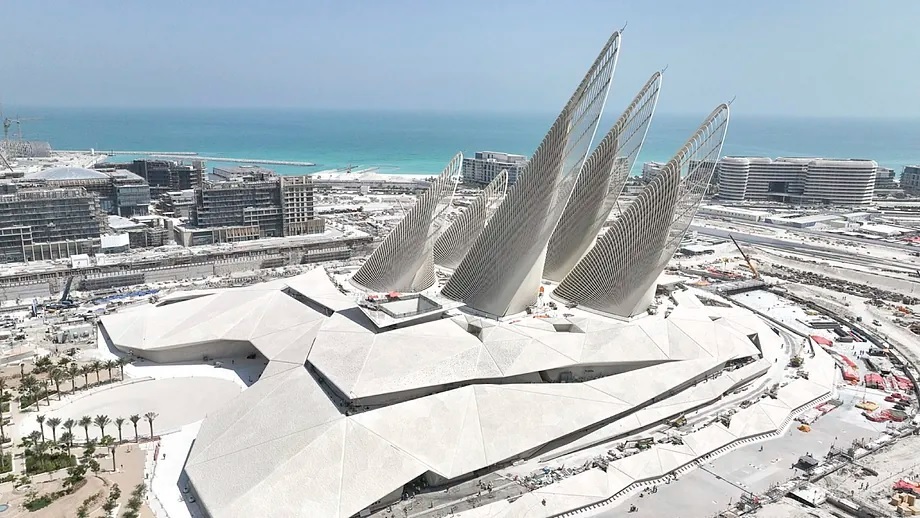A dozen official images, taken by drones in high resolution, began circulating from Abu Dhabi to the world last week. In these images, an immense white architecture appears in a somewhat suburban landscape with the deep blue sea in the background. Surrounding it are blocks of modern but somewhat conventional housing, highways, undeveloped plots... The building featured in the photographs is anything but conventional. It looks like a topography and, at the same time, a sculpture rather than a construction. It resembles a white and geometricized mountain, except for six metal pointed pieces that rise up to 123 meters in height at its center. Would it be correct to call them domes? Apparently, they function as cold chimneys that release hot air upwards, but the building's promoters use a metaphor, referring to the figures as wings. The plot measures 66,000 square meters and extends 260 meters on its long side, slightly less than the size of an Olympic stadium.
Is that a museum? Yes, it will be. It will be an archaeological museum and will open in Abu Dhabi in December of this year. The Zayed National Museum is a project that was first announced in 2010 with the aim of being completed in 2021 and serving as a complement to the Louvre Abu Dhabi, which has been open since 2017 on a plot 600 meters away. The images released last week announce that the wait is over, although the project has evolved over the years as the green roof that appeared in the 2010 infographics seems to have disappeared. The architectural firm of Norman Foster is the author of the complex.
In 2010, news about the Zayed National Museum was overshadowed by the myriad announcements of cultural investments coming from the United Arab Emirates, all somewhat extravagant. Now, with the passage of time and the certainty that the building is almost completed, it is time to reorganize the information: the name Zayed corresponds to Sheikh Zayed bin Sultan Al Nahyan, the founder of the United Arab Emirates as a modern state, and accordingly, its purpose is to express the history of the country. While the Louvre spoke of Abu Dhabi as an open city-state to the world, its national museum is intended as an inward look.
However, the building also has a European partner, just like its neighbor. The British Museum has had a contract since 2009 to oversee the new giant with professional advice and artworks. 500 pieces from the London museum originating from the Middle East will be exhibited at the Zayed National Museum. Will they be mid-range works like those seen at the Louvre? It is not yet known.
Another relevant fact that is clearer today than in 2010 is that both the Louvre Abu Dhabi and the Zayed National Museum are located on Saadiyat Island, a land north of the city, beyond the docks, often presented as a citadel of culture, a modern and oversized equivalent of Berlin's Museum Island. The reality shown in the photos is different: Saadiyat is actually a residential development where the succession of museums serves as an incentive to prevent boredom. In the coming years, there will be more inaugurations: a new Guggenheim by Gehry, a theater by Zaha Hadid...
The concept of the citadel is more fitting for the Grand Egyptian Museum designed by the Irish firm Heneghan Peng, which should already be the world's largest museum but whose definitive opening has been postponed to an uncertain date in 2026. In reality, everything is a bit complex: the Grand Egyptian Museum has been receiving visitors (up to 4,000 daily) since 2024, even though the works were not completed in its last and most important gallery, which will display Tutankhamun's treasure. The official opening was scheduled for May 5th, but the Egyptian government explained that the war in Gaza advised against holding any celebrations.
Those familiar with the old Egyptian Museum in Tahrir Square in Cairo can get an idea: its replacement is exactly the opposite in every way. It does not replicate the architecture of the great European museums of the 18th and 19th centuries but appears as an immense piece of land art excavated in the earth. It is not in the city center but emerges in a landscape of highways and sandy areas that, however, allows it to interact with the Giza pyramids. From the museum, there are windows that overlook the monuments. The new museum is not overflowing with archaeological pieces, nor is it dusty or as hot as a stove like the old Egyptian Museum. It is also not as insecure as the Tahrir building, which was looted during the 2011 riots. On the contrary, the new Grand Egyptian Museum is a fortified, efficient, and futuristic space in the midst of a country that has barely benefited from the boom of its Arabian Peninsula neighbors.
But above all, the building is a colossus. When it is finally inaugurated, it will showcase 100,000 pieces and offer 90,000 square meters of galleries, 36% more than the Louvre, which is currently the world's largest museum.
